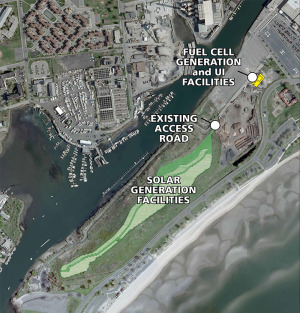Exploring the feasibility of solar and fuel cell energy production, Bridgeport has become a leader in renewable energy. The city is notable for its clean energy projects, including the building of the Dominion fuel cell park, the largest of its kind in North America.
Recently, another renewable energy project was approved. The state Siting Council voted in favor of the planned Green Energy Park, which calls for nearly 9,000 solar panels and a 2.8-megawatt fuel cell on Bridgeport”™s abandoned landfill. The Connecticut Department of Energy and Environmental Protection is reviewing an application submitted by The United Illuminating Co. The New-Haven based regional electric distribution company will oversee the execution and maintenance of the energy park project.

“We have to submit an application that says we will not disturb the landfill cap and let them know how we”™re doing the project,” said Thomas Judge, engineer of the United Illuminating solar project. “They may ask us for a licensed environmental professional to oversee portions of the work since we may be scraping the vegetation. They have 60 days to review it, so we anticipate having approval by Dec. 18 or 20.”
From there, the project will be shovel-ready, Judge said. It could break ground in December and be completed by August 2015. The aim is to create 92 jobs and bring $7 million in tax revenues to the city during the park”™s 20-year lease period.
The life of a fuel cell facility is normally 20 years. At the end of the 20 years, United Illuminating will evaluate the solar and fuel cell installations. If all goes well, it can extend its lease five years. At the end of the 25 years, if it is granted approval, UI can extend its lease for another five years, capping the lease agreement at a maximum of 30 years.
United Illuminating took the opportunity to vet Bridgeport”™s landfill before making the $23 million investment. The company weighed other possibilities, but the Bridgeport landfill proved to be the most suitable, Judge said. For more than 20 decades, the city”™s solid waste area was abandoned. Through a mechanical process, construction debris was placed on top of the waste and the pile was capped with a sealant in 2000.
Connecticut Light & Power and UI formerly owned the lines and systems that bring electricity to houses and businesses. But in the 1990s, the state legislature made a law that removed CL&P and UI from the energy generation business. Recently, the state legislature, wanting to encourage the development of renewable energy sources, has allowed UI to get back on the power generation market as long as it produces energy on moderate levels.
“We can build renewable energy sources to a certain maximum,” Judge said. “The state wants 20 percent of all energy to be from renewable resources by 2020, so we have to make sure our facilities operate at a minimum of 90 percent of the designed output.”
The Green Energy Park is part of the BGreen2020 initiative, a partnership between the private sector and city government as well as the Bridgeport Regional Business Council. The key goals of the 10-year sustainability plan are to create jobs, get off foreign oil and fight climate change, said Bridgeport Mayor Bill Finch.
“If you look at what”™s happening worldwide, the largest tool for fighting climate change is urbanization,” Finch said. “It”™s about getting people to live closer together, cutting down on vehicle miles traveled and living in economies of scale that will allow people to build mass transit. We need more adjoining walls to conserve energy and housing units that are built attached rather than detached. The whole urbanization trend will pay huge dividends.”














